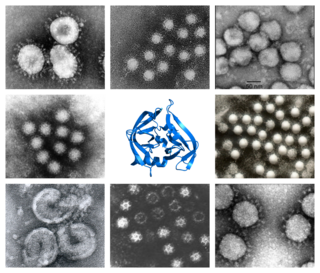Virus classification is the process of naming viruses and placing them into a taxonomic system similar to the classification systems used for cellular organisms.
Echovirus is a polyphyletic group of viruses associated with enteric disease in humans. The name is derived from "enteric cytopathic human orphan virus". These viruses were originally not associated with disease, but many have since been identified as disease-causing agents. The term "echovirus" was used in the scientific names of numerous species, but all echoviruses are now recognized as strains of various species, most of which are in the family Picornaviridae.

The International Committee on Taxonomy of Viruses (ICTV) authorizes and organizes the taxonomic classification of and the nomenclatures for viruses. The ICTV has developed a universal taxonomic scheme for viruses, and thus has the means to appropriately describe, name, and classify every virus that affects living organisms. The members of the International Committee on Taxonomy of Viruses are considered expert virologists. The ICTV was formed from and is governed by the Virology Division of the International Union of Microbiological Societies. Detailed work, such as delimiting the boundaries of species within a family, typically is performed by study groups of experts in the families.

Artoviridae is a family of negative-strand RNA viruses in the order Mononegavirales. Barnacles, copepods, odonates, parasitoid wasps, pile worms, and woodlice serve as natural hosts. The group name derives from arthropod the phylum of its hosts. Members of the family were initially discovered by high throughput sequencing.
Cossaviricota is a phylum of viruses.

Cressdnaviricota is a phylum of viruses with small, circular single-stranded DNA genomes and encoding rolling circle replication-initiation proteins with the N-terminal HUH endonuclease and C-terminal superfamily 3 helicase domains.
Arfiviricetes is a class of viruses.
Pimascovirales is an order of viruses. The term is a portmanteau of a portmanteau of pitho-, irido-, marseille-, and ascoviruses.
Pokkesviricetes is a class of viruses.
Revtraviricetes is a class of viruses that contains all viruses that encode a reverse transcriptase. The group includes all ssRNA-RT viruses and dsDNA-RT viruses. It is the sole class in the phylum Artverviricota, which is the sole phylum in the kingdom Pararnavirae. The name of the group is a portmanteau of "reverse transcriptase" and -viricetes which is the suffix for a virus class.
Duplornaviricota is a phylum of RNA viruses, which contains all double-stranded RNA viruses, except for those in phylum Pisuviricota. Characteristic of the group is a viral capsid composed of 60 homo- or heterodimers of capsid protein on a pseudo-T=2 lattice. Duplornaviruses infect both prokaryotes and eukaryotes. The name of the group derives from Italian duplo which means double, rna for the type of virus, and -viricota which is the suffix for a virus phylum.

Ghabrivirales is an order of double-stranded RNA viruses. It is the only order in the class Chrysmotiviricetes. The name of the class is a portmanteau of member families: chrysoviridae, megabirnaviridae, and totiviridae; and -viricetes which is the suffix for a virus class. The name of the order derives from Said Ghabrial, a pioneering researcher who studied viruses in this order, and -virales which is the suffix for a virus order.
Kitrinoviricota is a phylum of RNA viruses that includes all positive-strand RNA viruses that infect eukaryotes and are not members of the phylum Pisuviricota or Lenarviricota. The name of the group derives from Greek κίτρινος (kítrinos), which means yellow, and -viricota, which is the suffix for a virus phylum.
Alsuviricetes is a class of positive-strand RNA viruses which infect eukaryotes. The name of the group is a syllabic abbreviation of "alpha supergroup" with the suffix -viricetes indicating a virus class.
Nodamuvirales is an order of positive-strand RNA viruses which infect eukaryotes. The name of the group is a contraction of "Nodamura virus" and -virales which is the suffix for a virus order.
Tolivirales is an order of RNA viruses which infect insects and plants. Member viruses have a positive-sense single-stranded RNA genome. The virions are non-enveloped, spherical, and have an icosahedral capsid. The name of the group is a syllabic abbreviation of "tombusvirus-like" with the suffix -virales indicating a virus order.

Pisuviricota is a phylum of RNA viruses that includes all positive-strand and double-stranded RNA viruses that infect eukaryotes and are not members of the phylum Kitrinoviricota,Lenarviricota or Duplornaviricota. The name of the group is a syllabic abbreviation of “picornavirus supergroup” with the suffix -viricota, indicating a virus phylum. Phylogenetic analyses suggest that Birnaviridae and Permutotetraviridae, both currently unassigned to a phylum in Orthornavirae, also belong to this phylum and that both are sister groups. Another proposed family of the phylum is unassigned Polymycoviridae in Riboviria.

Pisoniviricetes is a class of positive-strand RNA viruses which infect eukaryotes. A characteristic of the group is a conserved 3C-like protease from the PA clan of proteases for processing the translated polyprotein. The name of the group is a portmanteau of member orders "picornavirales, sobelivirales, nidovirales" and -viricetes which is the suffix for a virus class.

Sobelivirales is an order of RNA viruses which infect eukaryotes. Member viruses have a positive-sense single-stranded RNA genome. The name of the group is a portmanteau of member orders "sobemovirus-like" and -virales which is the suffix for a virus order.

Stelpaviricetes is a class of non-enveloped, positive-strand RNA viruses which infect plants and animals. Characteristic of the group is a VPg protein attached to the 5'-end of the genome and a conserved 3C-like protease from the PA clan of proteases for processing the translated polyprotein. The name of the group is a syllabic abbreviation of member orders "stellavirales, patatavirales" with the suffix -viricetes denoting a virus class.







